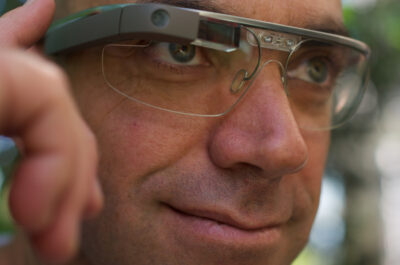We’ve recently been doing a number of interviews on the Quantified Self, the trend of capturing behavioral and body data for analysis and sharing. One of the questions that keeps popping up in these interviews and everyday conversations alike is: Where will this lead down the road? In other words, how will our life change if we continue on this path?
It’s a loaded question of course, and has many aspects – of societal change, the perception of the self, business models, privacy, ownership and control, just to name a few.
So I’m going to engage in a little speculation and write a scenario of an everyday scene. Please think of it as playful exploration, a thought experiment rather than full-blown forecasting scenarios or predictions.
# 1 Ramp up your Med Credits
It’s 2020. Patrick wakes in his sleep pod that’s just large enough for him to stretch out. As every morning, the first thing he does is active his in-pod computer. “Show me my vital signs and prepare an appropriate breakfast.” While he climbs out of the sleep pod and walks over to the shared kitchen area, the internet fridge pours a bowl of porridge-like nutritional mash. “Darn,” Patrick thinks, “the flavor cartridge has to be replaced, the taste is all off.” The moment he puts down his bowl, his connected smartphone uses the in-house speaker system to remind him that he has a 30 minute workout coming up: He’s running low on Med Credits, and if he doesn’t fullfil his weekly fitness duties, he’ll lose his health insurance for the month. Swearing, he heads over to the in-house gym. After all, there’s no way around it. You can’t cheat the body sensors…
Not really, tough, right?
Not really, no. However, reading the media reports and talking to the critics of self-tracking, one could get the impression that something like this is the worst case scenario they have in mind. We hope and believe that a scenario like the following is much more likely than that extreme case.
# 2 A visit to the doc in 2020
Here’s the scene: It’s 2020. Eight years from now, the thing called “Quantified Self” has become integrated in our daily lives. Nobody really mentions it anymore, it’s just become normal.
Mara is on her way to the doc for a quick checkup. Last night she had been out with her friends when she felt a little dizzy. Through the heartbeat sensor in her necklace, her phone had picked up the change of her pulse and reacted immediately: It asked her a couple of questions to make sure she was ok and no external help was needed, and asked if she’d like to see the doc just to make sure she’s ok. “Better safe than sorry,” she thought, and punched the OK button. Matching her calendar with her doc’s, the Medical App coordinated and confirmed an appointment for the next morning.
Sitting on the subway, Mara listens to an audiobook while preparing for the doc. The doc’s software, as usual, is preparing a small dossier for him so he’s up to speed on her health. She confirms his requests to pull together some data from her body sensors to check for any major changes over the last few months as well as her nutritional and food logs. Through her app, the doc’s software also asks if she had been exposed to a lot of stress. She can’t help thinking of the red warning light on her banking app – it had been a pretty expensive month, and her salary was still overdue. “Medium stress,” she tells the doc’s software, and prepares to leave the subway.
“Anything else we should know?” asks the software while Mara walks towards the doc’s building. She considers for a moment, then remembers that her DNA analysis had shown a slightly above-average predisposition to high blood pressure. She was very conscious of that kind of data and wouldn’t give it to her health insurance – she had heard rumors they might decide to put some exceptions on her health coverage and wouldn’t want to take that risk. “It might be relevant for the doc, though,” she thinks as she sends that part of her DNA analysis over to the doc.
Entering the doc’s practice, the friendly young woman at the reception asks her to take a seat in the waiting room for a few minutes.
When her name is called and she enters the office, the doc is already familiarizing himself with the data she had sent earlier. “Nothing major in here, but it seems that last night you had a bit of a fast heartbeat. Let’s see if it’s anything serious.” He runs his tests, and adds the results to her dossier to be synced back to her. It turns out not to be too bad. “The data shows that you’ve slept somewhat irregularly for the last few days, though. Maybe try to skip the espresso after 9pm for the next week and see how that goes.”
10 minutes later, Mara is leaving the practice. On her way out, the receptionist says goodbye, remarking: “I’ll sync some background information about improving sleep and about blood pressure with your phone. There was just a study that shows a connection to eating greens.” Laughing, she adds: “Well, not a whole lot of news there, right?” Plugging in her earphones, Mara heads back to work. Nothing to worry about. It’s good to know for sure.
So, what now?
As scenarios goes, this one isn’t terribly exciting. No blood, no action, right? That’s for good reasons.
One, we think about technology and its implications for society – not medical issues. So rather than making up something spectacular and quite possibly wrong, I went for a false alert here. Forgive me for this not-so-cunning literary device.
Two, it’s that element of the mundane, the fact that the whole thing is really quite unspectacular, that is the point here. Today, the notion of consciously tracking our behavior seems odd, almost freakish. It seems something for nerds, or those with the medical need to track. But fairly soon, as networked sensors become ubiquitous and data plans on smartphones become really, really cheap, this is going to change. We’ll look back at today and wonder how people didn’t freak out over not knowing if something was wrong, and over not having an early detection system in place for emergencies. All this is, of course, just a matter of getting used to new circumstances. It’s in the very nature of change.
In a recent interview, we were asked why dig into emerging topics. It’s quite simple, really. We’d like to help shape emerging trends for the better. To make sure that user rights are respected in whatever is built by the folks we work with, we want to be on top of stuff. Because oftentimes, even the big decisions are made in a moment during a conversation, sometimes without that much deliberation. We expect of ourselves to be able to make a good call in that moment. To make most of the near future, in whichever role we can.
By the way, we’re not the only ones engaging in speculation about the future of the Quantified Self. For a slightly different take – that’s also better written – we recommend Cory Doctorow’s short story ‘The Things that Make Me Weak and Strange Get Engineered Away’ from his collection With A Little Help.
Dieser Artikel ist zuerst erschienen auf thirdwaveberlin.com
Artikel per E-Mail verschicken
Schlagwörter: medical, qs, Quantified Self, scenario




